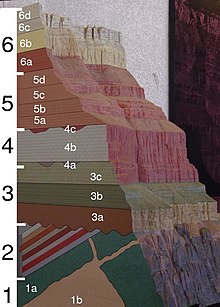Geological formation
This article includes a list of references, related reading, or external links, but its sources remain unclear because it lacks inline citations. (November 2013) |

A formation or geological formation is the fundamental unit of lithostratigraphy. A formation consists of a certain number of rock strata that have a comparable lithology, facies or other similar properties. Formations are not defined on the thickness of the rock strata they consist of and the thickness of different formations can therefore vary widely.
The concept of formally defined layers or strata is central to the geologic discipline of stratigraphy. Formations can be divided into members and are themselves frequently parcelled together in groups.
Usefulness of formations
The definition and recognition of formations allow geologists to correlate geologic strata across wide distances between outcrops and exposures of rock strata.
Formations were initially described to be the essential geologic time markers based on relative ages and the law of superposition. The divisions of the geological time scale were the formations described and put in chronological order by the geologists and stratigraphers of the 18th and 19th centuries.
Modern revision of the geologic sciences has restricted formations to lithologies, because lithological units are formed by depositional environments, some of which may persist for hundreds of millions of years and will transgress chronostratigraphic intervals or fossil-based methods of correlating rocks. For example, the Hamersley Basin of Western Australia is a Proterozoic sedimentary basin where up to 1200 million years of sedimentation is preserved within the intact sedimentary stratigraphy, with up to 300 million years represented by a single lithological unit of banded iron formation and shale.
Geologic formations are usually sedimentary rock layers, but may also be metamorphic rocks and volcanic flows. Igneous intrusive rocks are generally not divided into formations.
Defining lithostratigraphic formations

Formations are the only formal lithostratigraphic units into which the stratigraphic column everywhere should be divided completely on the basis of lithology.
The contrast in lithology between formations required to justify their establishment varies with the complexity of the geology of a region and the detail needed for geologic mapping and to work out its geologic history.
Formations must be able to be delineated at the scale of geologic mapping practiced in the region. The thickness of formations may range from less than a meter to several thousand meters.
Geologic formations are typically named for the geographic area in which they were first described.
Strictly, formations cannot be defined on any other criteria except primary lithology. However, it is often useful to define biostratigraphic units based on paleontological criteria, chronostratigraphic units based on the age of the rocks, and chemostratigraphic units based on geochemical criteria.
Sequence stratigraphy is a concept which challenges the idea of strict lithostratigraphic units by defining units based on events in sedimentary basins such as oceanic regressions and transgressions. These sequences are a combination of chronostratigraphic units, linked by time, and depositional environment linked by the geologic events which occurred at that time, regardless of the grain size of the sediments.
The term "formation" is often used informally to refer to a specific grouping of rocks, such as those encountered within a certain depth range in an oil well.
Other uses of the term
"Formation" is also used informally to describe the sometimes odd shapes (forms) that rocks acquire through erosional or depositional processes. Such a formation is said to be abandoned when it is no longer affected by the geologic agent that produced it. Some well known cave formations include stalactites and stalagmites.
See also
Further reading
- Brookfield, Michael E. (2008). Principles of Stratigraphy. John Wiley & Sons. pp. 111–114, 200. ISBN 9780470693223.
- Rey, Jacques; Simone Galeotti, eds. (2008). Stratigraphy : terminology and practice. Paris, France: Editions OPHRYS. ISBN 9782710809104.
